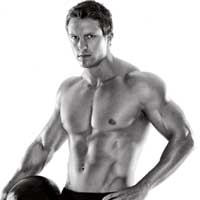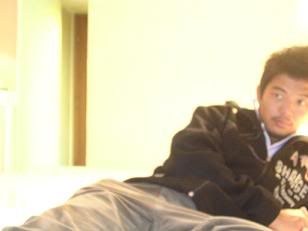
Yesterday I had a good and intense workout focussing on my upper body. I did chest, shoulder, back triceps and biceps exercise. As for the chest exercise, I did intense dumbbell bench press starting from 30lbs. After the chest exercise, I felt my slab of muscles burning with fatigue and quickly moved on to the shoulders which again received rigorous treatment. Until the last "High point", I could not take it any longer but persisted to hit the last repetition before the shoulder screamed to surrender to the pain. Then, after a short break, I moved on to the back exercise which was relatively manageable before next tricep and biceps. As for the biceps exercise, my biceps again received tough treatment as I could not lifr 30lbs on my own. I had to support my left arm with my right arm to lift the dumbbell. The same thing goes for my right arm. Then after the "High Point", whole upper part was groaning in pain but I feel so good to challenge my body to push towards its limit.
Here is a little information from Men Health MagazineThe Payoff
THE MUSCLES THAT MAKE AN IMPACT
Your chest is composed of two muscle groups: the pectoralis major and a smaller, deeper group called the pectoralis minor. Changing the angle of your body during classic chest exercises can challenge different parts of these muscle groups for maximum development. The anterior deltoids--the front of the shoulders--and the triceps assist your pectoral muscles. Strengthen them and you can use heavier weights for even more growth.
Goal 1: Impressive Power!
The bench press is typically--though incorrectly--considered the true measure of a man's strength. A powerful chest will give you an impressive answer to the classic question "Whaddaya bench?" And people will think you must be equally strong in other exercises.
Goal 2: A Thinner Waistline!
Building a bigger, stronger chest also adds size to your shoulders and triceps, widening the top of your body. The larger you are on top, the smaller your waistline appears. So if your diet and aerobic plan are lagging, building a larger upper body will create the illusion of a thinner midsection.
Goal 3: More Fat Burning!
Swimming burns an astounding 280 to 400 calories in 30 minutes, depending on the stroke--with little risk of injury. Stronger pectoral and shoulder muscles give you more pulling power with every stroke and can keep your upper body from tiring out before your legs do. So you can stay in the water for a longer workout.Goal 4: An Edge in Sports!
A strong chest is a big advantage in sports: setting picks in hoops, pushing off in football. Extra muscle packed onto your upper body also protects you against errant elbows and intentional punches. Build a bigger chest and you'll dominate.
BENCH-PRESS SUPERSET:
Barbell Bench Press (works chest, shoulders, triceps)
Lie on a bench with your feet flat on the floor. Grab the barbell with an overhand grip (palms facing away from you), your hands slightly wider than shoulder-width apart. Remove the bar from the uprights and position it above your chest with your arms straight. Slowly lower the bar to your chest, just below your nipples. Pause, then press the weight back up until your arms are straight again. After finishing the set, return the bar to the uprights and move to the dumbbell bench press.
Dumbbell Bench Press (works chest, shoulders, triceps)
Grab a pair of dumbbells and lie back on the bench, positioning the weights along the sides of your chest. Press the dumbbells straight up, lower them, and repeat for one set.
WATCH YOUR FORM: During both the barbell and dumbbell bench presses. avoid arching your back as you push the weight above your chest. That puts your spine at risk of injury. Instead, press your back into the bench and keep your abs drawn in
SECTION 1:
(Click the links to view the videos)
Seated Twisting Cable Fly (works inner chest)
Sit on a bench between the towers of a cable-crossover station and grab a handle from the bottom of each weight stack. Slide forward on the bench until your arms are extended slightly behind you. Maintaining a slight bend in your elbows, slowly draw your hands forward until your arms are in front of your chest. As you go, rotate your hands so your palms face out at the top. Pause, then reverse the motion back to the starting position.
WATCH YOUR FORM: Keep your torso upright to avoid unnecessary stress on your lower back.
Open-Hand Fly (works inner chest)
Grab a pair of light dumbbells and lie on a flat bench, arms extended above your chest, palms facing each other. Maintaining a slight bend in your elbows, slowly lower your arms out to the sides until your upper arms are parallel to the floor. As you go, open your hands so the weights are balanced in your palms. Pause, then slowly draw your arms back up, wrapping your fingers around the weights.
WATCH YOUR FORM: Go slowly until you feel comfortable. Opening your hands places more emphasis on your chest muscles.
SECTION 2:
Barbell Incline Press (works upper chest)
Lie on an incline bench, holding a barbell above you at arm's length with your hands shoulder-width apart. Keeping your head, torso, and hips pressed to the bench, slowly lower the bar to your chest. Pause, then press the bar up and slightly back so it finishes above your chin.
WATCH YOUR FORM: Pay attention to where the bar touches your chest; it should touch the top portion. Ending up at a point too high or low shifts your arms out of alignment and can direct more stress onto your shoulders.
Open-Hand Incline Fly (works upper chest)
Grab a pair of light dumbbells and lie on an incline bench, arms above your chest, palms facing each other. With a slight bend in your elbows, slowly lower your arms out to the sides until the weights are in line with your chest. As you lower the weights, open your hands, balancing the weights in your palms. Slowly sweep your arms back up, wrapping your fingers around the weights as you go.
WATCH YOUR FORM: Keep the weights above your chest--not your face--at the top of the movement. This keeps effort focused on the upper chest, not the shoulders.
SECTION 3:
(Click the links to view the videos)
Dumbbell Decline Bench Press (works lower chest and shoulders)
Lie on a decline bench with your lower shins beneath the leg supports at the end, or as shown here. Hold a pair of dumbbells along the sides of your chest, palms facing forward. Push the weights up above your chest until your arms are extended. Slowly lower the weights to the starting position.
WATCH YOUR FORM: Resist the urge to try to look at the weights as they reach your chest; this can strain your neck. Keep your head flat on the bench at all times.
Cable Crossover (works inner pectorals)
Stand between the towers of a cable-crossover station and grab a high-cable handle in each hand. Extend your arms out from your sides, with your elbows unlocked and palms down. Keeping your arms straight, slowly pull the handles down in a wide arc, bringing your palms together just below your waist. Contract your chest muscles for 2 seconds, then slowly return to the starting position.
WATCH YOUR FORM: Only your arms should move. Leaning or hunching uses your abdominals and back muscles.
SECTION 4:
Dumbbell Close-Grip Bench Press (works triceps)
Grab a pair of dumbbells with an overhand grip and lie on a bench, feet flat on the floor. Extend your arms above your chest and touch the ends of the dumbbells together. Keeping the weights touching and your elbows close to your sides, slowly lower the weights toward your chest, then press them up.
WATCH YOUR FORM: The close grip hits the triceps. But men with strong enough triceps to use large dumbbells may find the move difficult. If that's you, use a barbell and space your hands closer than shoulder-width apart.
Parallel Dip (works triceps)
Lift yourself at a dip station so your weight rests on your hands, and your arms are straight but not locked. Bend your knees and cross your ankles. Keeping your elbows close to your sides, lower yourself for a count of 4 seconds until your upper arms are parallel to the floor. Press yourself back up, and don't lock your elbows at the top.
WATCH YOUR FORM: Keep your head in line with your spine and hold your body upright. If your shoulders go too far forward, your lower-chest muscles take work away from your triceps.


0 Comments:
Post a Comment
<< Home